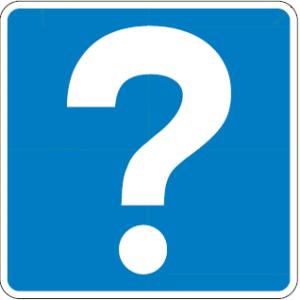Sign, sign, everywhere a sign.
Blocking out the scenery, breaking my mind.
Do this, don’t do that.
Can’t you read the sign?
“Signs” The Five Man Electrical Band
So you are driving down the road some dark and stormy night, and you see a cobalt blue sign with a white question mark on your right. Should you:
A: Wonder, wonder who?
B: Be prepared for whatever might come your way?
C: Be afraid, be very afraid?
D: Get your questions ready for the tourist information representative.
Well, if you’ve done a lot of traveling, you probably know that this is the symbol for a tourist information location, though it still is a big question mark in the minds of many.
And the cold hard fact is if you don’t like these signs, you’ve got a bit of an uphill climb to get them changed. The National Committee on Uniform Traffic Control Devices, which consists of about 250 traffic management experts, review the signs in the Manual on Uniform Traffic Control Devices about every five years, with a specific directive to NOT change them very much.
“If anyone really wanted to change something, we’d have to refer them to those guys,” said Jared Fiel, the regional manager of communication for the Colorado Department of Transportation. But, “we don’t get a lot of complaints about the signs themselves, mostly requests to change the speed limit or something like that.
“And not all of them really apply to Colorado,” Fiel added. “I don’t think we’re going to see that ‘hurricane route’ sign anytime soon.’”
At least in CDOT’s Region 4, the northeast quarter of the state, the question usually is whether or not to just have this sign, a larger motorist-services sign, or a sign at all, because the Five Man Electrical Band weren’t the only ones who preferred seeing a tree to a sign.
“We do have a whole department looking at traffic signs and keeping that fine line between the information that drivers need and giving the drivers too many things to hit,” offered Fiel.
Signage improvements are usually taken care of on a regional basis, and this year Fiel’s Region 4 has been addressing a significant need: How to keep people driving on county roads from blowing their Priuses through the intersections with state highways.
“Most of the county roads aren’t state highways so we can’t do rumble strips or anything,” he said. “So the most we can do is make that stop sign as recognizable as possible. We’re putting in state highways signs in advance of those stop signs and we’re making them a little larger.”
The change was made after a number of such accidents have occurred over the past few years. In fact, CDOT is making a big effort to improve the intersection of Weld County Road 31 and Colorado 14, just west of Ault.
“It’s our first illuminated stop sign. It’s solar powered so we’re going to see how that works out,” Fiel said. “Most of the accidents here have been because (motorists) didn’t stop at the intersection. We’ll see if that sign doesn’t help that.”
Fiel said Region 4 does handle a number of calls about signs every year, and often they are helpful. For instance, drivers recognizing that state highway signs are amiss after street changes have been made inside municipalities.
Other sign questions are often about getting store information on exit signs. For the record, the ones on the interstate usually cost money, but the information for all such programs is at: www.coloradodot.info/programs/logos-tods.html.
In the meantime, please read the signs.
Support Northern Colorado Journalism
Show your support for North Forty News by helping us produce more content. It's a kind and simple gesture that will help us continue to bring more content to you.
BONUS - Donors get a link in their receipt to sign up for our once-per-week instant text messaging alert. Get your e-copy of North Forty News the moment it is released!
Click to Donate


